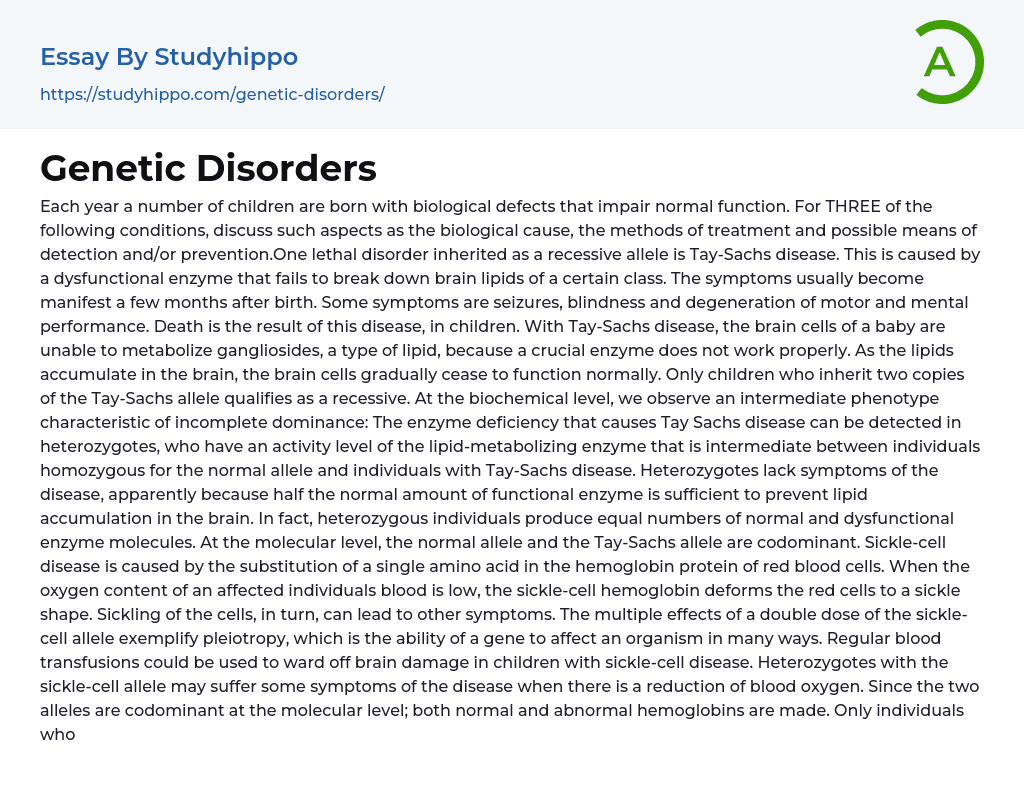The text discusses three specific conditions in children with biological defects that impede normal function. One of these conditions is Tay-Sachs disease, an inherited disorder caused by a recessive allele. This disease occurs when a dysfunctional enzyme fails to break down certain class of brain lipids. Symptoms typically appear a few months after birth and include seizures, blindness, and degeneration of motor and mental abilities. Tay-Sachs disease leads to death in affected children.
In babies with this disease, the deficiency of an enzyme prevents brain cells from metabolizing gangliosides- a type of lipid. Consequently, there is a gradual accumulation of these lipids in the brain leading to the deterioration of normal brain function.
Only children who inherit two copies of the Tay-Sachs allele are susceptible to developing the disease. At the biochemical level, individuals with one copy of the Tay-Sachs allele exhibit a
...n intermediate phenotype indicating incomplete dominance: their deficiency in lipid-metabolizing enzyme can be observed through their activity level falling between those with the normal allele and those with Tay-Sachs disease.
However, heterozygotes do not display symptoms because having half of the functional enzyme is sufficient to prevent lipid buildup in the brain. Individuals who are heterozygous for Tay-Sachs disease produce equal amounts of normal and dysfunctional enzyme molecules at the molecular level.The Tay-Sachs allele and the normal allele demonstrate codominant characteristics. Sickle-cell disease is a consequence of a single amino acid substitution in the hemoglobin protein of red blood cells. When an individual with this condition has low oxygen content in their blood, it leads to deformity in the red cells caused by sickle-cell hemoglobin, resulting in various symptoms. Pleiotropy, which refers to a gene's ability
to affect an organism in multiple ways, is exemplified by the multiple effects observed when an individual possesses two copies of the sickle-cell allele. Regular blood transfusions are used for children with sickle-cell disease to prevent brain damage. Heterozygotes carrying the sickle-cell allele may experience certain symptoms if there are reduced blood oxygen levels. At a molecular level, both normal and abnormal hemoglobins are produced because the two alleles exhibit codominance. Only individuals who have two copies of the sickle-cell allele will experience this disease. Down syndrome occurs when fertilization involves one abnormal gamete and one normal gamete, resulting in offspring with an abnormal chromosome number due to extra chromosomes being present. Each body cell contains 47 chromosomes, making it trisomic for chromosome 21. Down syndrome causes significant changes in phenotype, including distinctive facial features, short stature, heart problems, susceptibility to respiratory infections, and intellectual disability.The majority of cases of Down syndrome are caused by errors during gamete production in one parent, known as nondisjunction. Nondisjunction can occur when chromosomes do not separate correctly in either meiosis I or meiosis II. This results in one gamete having two copies of a chromosome type, while another gamete has none. Advanced maternal age is associated with an increased risk of carrying a trisomic embryo to term instead of experiencing spontaneous abortion. Amniocentesis is a diagnostic procedure that can be used to detect Down syndrome by analyzing cells from the amniotic fluid collected during pregnancy. Chorionic villus sampling provides faster results within 24 hours and involves removing a small amount of fetal tissue from the placenta.
- Microbiology essays
- Bacteria essays
- Cell essays
- Enzyme essays
- Photosynthesis essays
- Plant essays
- Natural Selection essays
- Protein essays
- Viruses essays
- Cell Membrane essays
- Human essays
- Stem Cell essays
- Breeding essays
- Biotechnology essays
- Cystic Fibrosis essays
- Tree essays
- Seed essays
- Coronavirus essays
- Zika Virus essays
- Anatomy and Physiology essays
- Addiction essays
- Biodegradation essays
- Dental Care essays
- Disease essays
- Disorders essays
- Health Care essays
- Intelligence Quotient essays
- Nutrition essays
- Olfaction essays
- Public Health essays
- Women's Health essays
- World health organization essays
- Cancer essays
- Infectious Disease essays
- Lung Cancer essays
- Neurology essays
- Physical Exercise essays
- Medicine essays
- Sex essays
- Inquiry essays
- Disability essays
- Poison essays
- Action Potential essays
- Nervous System essays
- Childbirth essays
- Puberty essays
- Blood essays
- Kidney essays
- Neuron essays
- Body essays




